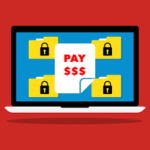Ransomware Attacks Surpass a Billion Dollars a Year
When we first started hearing about ransomware attacks, the ransoms started at a few hundred dollars per attack, then it moved to thousands. Just this week, a college in California paid $28,000 to get their files back after a ransomware attack. Depending on the size of your organization, an attack that size could bankrupt you or at least hurt your checkbook some. In 2015, the FBI announced ransomware attacks profited 24 million dollars. They just released a statement indicating ransomware attacks are expected to have exceeded one billion dollars in 2016. If you have the mindset that ransomware attacks can’t or won’t happen to your organization, this figure should cause you some pause. Not only are the amount of the ransomware attacks increasing, but the number of attacks per year is increasing at a scary level. Not to mention the fact that new strands of ransomware are being introduced faster than technology companies can identify a fix or prevention strategy for the ones already attacking.

Just this week a new family of ransomware called Spora, was uncovered. This ransomware demonstrates a solid encryption routine, ability to work offline, and a very well put together ransom payment site, which is the most sophisticated we’ve seen from any ransomware yet. Currently, the Spora ransomware is distributed via spam emails that pretend to be invoices. These emails come with attachments in the form of ZIP files that contain HTA files. Unlike most of today’s ransomware families, Spora works offline and does not generate any network traffic to online servers. The new Spora appears to be a professional ransomware put together by a crew with previous experience in ransomware distribution. It has been about a year since Locky and Cerber have been attacking users. Spora seems to be a ransomware family as advanced and well designed as Cerber and Locky. Although Spora is only attacking users in Russia, a ransomware this sophisticated will soon be seen attacking users all over the world.
Experts are predicting the year 2017 will bring ransomware attacks to cloud technologies. The adoption of cloud technologies by organizations has created an untapped market for hackers, and one that also deems an easier field to spread a string of ransomware in a shorter period of time. Individual attacks have still been the biggest target, but mostly because they are deemed the easiest. We are most likely going to see a shift in 2017 to more corporate attacks, as these net the biggest profit for hackers. Cloud technologies could be the way these attacks surpass individual attacks for 2017. One type of targeted individual attack we will see this year is on devices that use the Android operating system. Symantec has already discovered ransomware called “Flocker” that can lock Android smart TVs.
So what should you do? Understand first that everybody is at risk. Everyone who goes online needs to be prepared for a ransomware attack and take steps to protect themselves against an attack. Next, you need to have a decision made prior to getting infected if you are willing to pay the ransom or not. This decision is best made when you are not in an emotional state due to being under attack. In 2016, about 2/3 of victims paid the ransom. The FBI continues their stance that individuals and organizations should not under any circumstances pay the ransom. By continuing to pay ransoms, we are encouraging hackers to continue attacks, and at a great frequency and cost to victims. The last thing you can do is take steps to protect yourself and your organization from being the victim of an attack. Be careful what you click on, what attachments you open, back up all your data, update and patch your software, delete old applications, and disable macros.
If you need help protecting yourself or your organization from ransomware attacks, 2W Tech has certified IT Consultants on staff that can help. Give us a call today.
Read More:
Defend Against Ransomware
Benefits of Using Microsoft Azure
Don’t Be Extorted eBook
Enjoyed reading this article? Click the button below to download this asset.
Download “Don’t Be Extorted” Now
Don't Be Extorted: How to Keep Your Company and Personal Data Secure
Please complete the form to download the file.